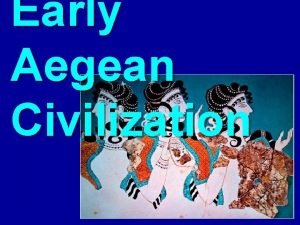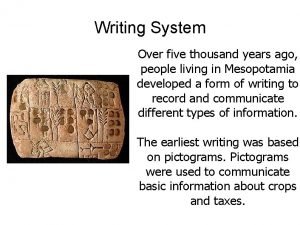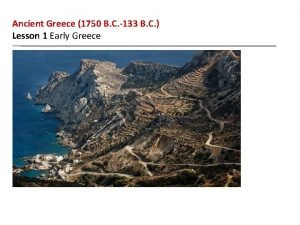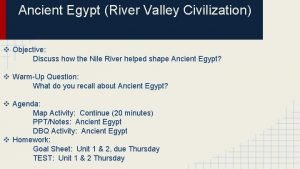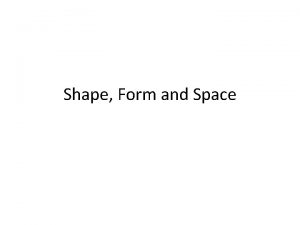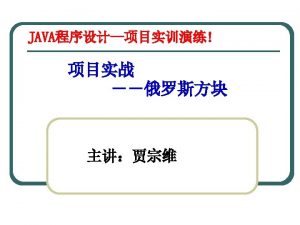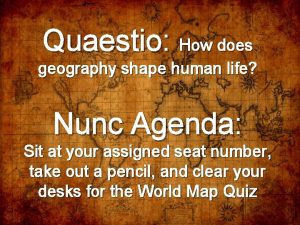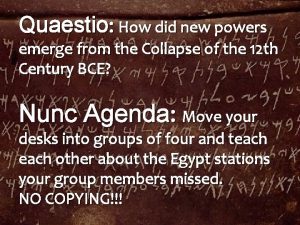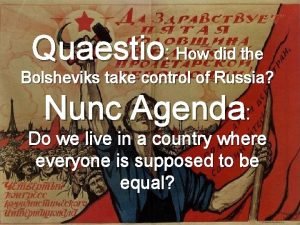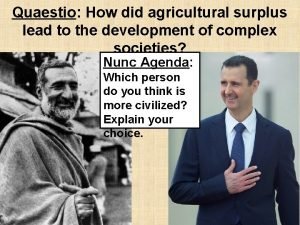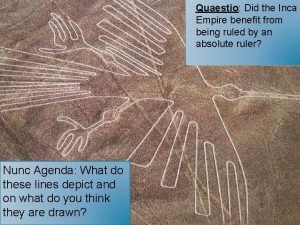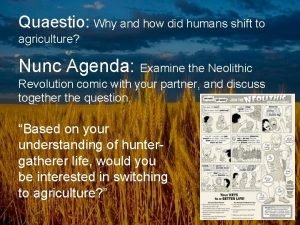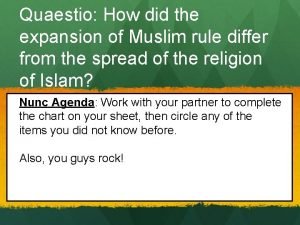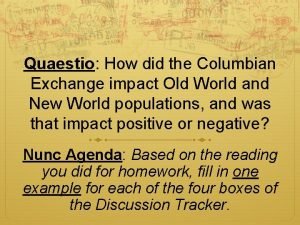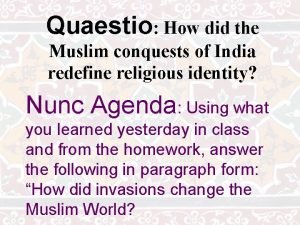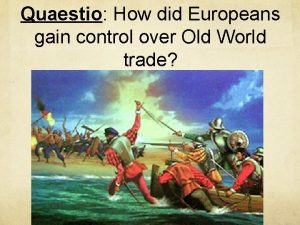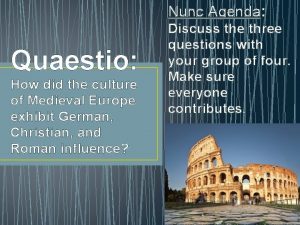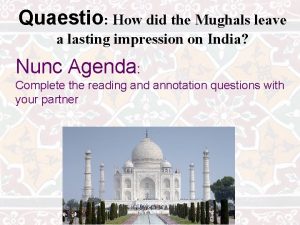QUAESTIO How did the environment shape the early
































- Slides: 32

QUAESTIO: How did the environment shape the early river valley civilizations? NUNC AGENDA: Write down as many cool facts about the Indus civilization that you can remember from the video

QUAESTIO: How did the environment shape the early river valley civilizations? NUNC AGENDA: Work in groups to finish Cuneiform Chronicles activity

THE BIG FOUR RIVER VALLEYS • River valleys = Fertile: seasonal floods deposit silt into the soil, making surplus possible • Silt = sediment carried by river water, somewhere between sand clay, full of nutrients • Rivers can also facilitate travel and trade

CONTROL OVER WATER • Excessive flooding can destroy settlements and crops, and even cause deaths • Infrequent flooding leaves crops without sufficient water • Solution = Irrigation systems for bringing water to crops & Dikes to hold back flood waters • Required organization and coordination � Governments develop to oversee and direct • Some easy to control water (Egypt, Indus), some difficult (Mesopotamia, China, Yucatan)

THE BIG FOUR RIVER VALLEYS • Mesopotamia (several civilizations): Tigris & Euphrates Rivers – Modern Iraq & E Syria

Meso = Between Potamia = Rivers

THE BIG FOUR RIVER VALLEYS • Indus Civilization (aka Harappan Civilization): Indus River – Modern Pakistan & NW India

THE BIG FOUR RIVER VALLEYS • Egypt & Nubia: Nile River – Modern Egypt and Sudan

THE BIG FOUR RIVER VALLEYS • Xia & Shang China: Yellow River (aka Huang He River) – Modern NE China

MORE THAN FOUR • There were other important early civilizations that developed in areas where fertile land could be cultivated to produce surplus

MORE THAN FOUR • There were other important early civilizations that developed in areas where fertile land could be cultivated to produce surplus

CONNECTION AND ISOLATION • Civilizations like Mesopotamia, Egypt, and the Indus Valley were very connected by trade and cultural diffusion due to geographic closeness and lack of barriers • China was more isolated from the others, mostly due to the Himalaya Mountains • The Americas were completely isolated, being separated by massive oceans

CONNECTION AND ISOLATION • Civilizations like Mesopotamia, Egypt, and the Indus Valley were very connected by trade and cultural diffusion due to geographic closeness and lack of barriers • China was more isolated from the others, mostly due to the Himalaya Mountains • The Americas were completely isolated, being separated by massive oceans

Music Time! Listen close! What language is this?

CITY–STATES – CASE STUDY THE SUMERIANS • Sumerians = the earliest civilization, located in Southern Mesopotamia, a collection of city-states • Each city-state had one central city that controlled the lands surrounding it • City: Center of political and military control as well as trade and religious ritual • State: Wider lands which included many small villages and agricultural land

Meso = Between Potamia = Rivers


Sumer = First Civilization

CITY–STATES – CASE STUDY THE SUMERIANS • Politically divided but culturally united • Different rulers but shared language, religion, customs, trade • Spoke Sumerian, a language isolate (not related to any other known language)

DEVELOPMENT OF WRITING • Most early writing began as pictograms, symbols designed to look like things they represent, but later developed into more abstract forms, and came to represent sounds rather than things • Sumer: Cuneiform was the first system of writing ever invented, used for many different languages of peoples in and around Mesopotamia



DEVELOPMENT OF WRITING • Egypt: While not the first, Heiroglyphics was the ancestor script of many modern scripts, including our own! • The Egyptians borrowed the idea of writing from Mesopotamia

DEVELOPMENT OF WRITING • Writing developed (probably) three times independently • Other than Cuneiform in Sumer, the Oracle Bone Script was developed in China and the Olmec script was developed in Mesoamerica by the Olmecs


OTHER TECHNOLOGIES • Bronze: 4000 BCE Mesopotamians strengthened soft copper with tin to make the alloy metal called bronze, used for durable tools and weapons, but very expensive because of the rarity of tin • Wheel: 3500 BCE Sumerians began using wooden wheels, and wheeled carts by 3000 BCE, which dramatically improved transportation of large and heavy goods

TRADE NETWORKS • Specialized labor + more efficient transportation (land water) + geographic differences = Long-Distance Trade • River valleys often resource poor, had to trade with neighbors for special raw materials like lumber, tin, textiles, skins, dyes, gold, gems, slaves etc • Trade works best with healthy peaceful relations, though often continues even during hostility and war

TRADE NETWORKS • Indus Valley traded with Southern/Eastern India and Mesopotamia • Mesopotamia also traded with Asia Minor, Levant, and Egypt

TRADE NETWORKS • Egypt also traded throughout Eastern Mediterranean and upstream of Nile with Nubia and along the coast of East Africa • China had only very limited trade to the West but traded with their neighbors in East Asia • Contact and trade leads to cultural diffusion – exchange of ideas and technology

RELIGIOUS BELIEFS • Mostly polytheistic – belief in many gods (poly = many; theos = god) • Pantheon = collection of gods within a polytheistic system (pan = all) • Though less common, some examples of monotheism – belief in one god (mono = one)

Lamassu = Protector God

RELIGIOUS BELIEFS • Influenced by agriculture • Fertility still important as with Paleolithic, now focused on crops • Major themes = cycles of birth, death, and rebirth, just like crops and seasons • Most religions had stories of a major destruction by a flood, often sent by the gods
 Early cpr and early defibrillation can: *
Early cpr and early defibrillation can: * Environment of business finance
Environment of business finance Drag divergence mach number
Drag divergence mach number Shape matching and object recognition using shape contexts
Shape matching and object recognition using shape contexts Shape matching and object recognition using shape contexts
Shape matching and object recognition using shape contexts About early humans for class 6
About early humans for class 6 Anasazi religion
Anasazi religion How did the nile shape ancient egypt essay
How did the nile shape ancient egypt essay How did geography help shape greek civilization
How did geography help shape greek civilization Why did the barley sign change shape
Why did the barley sign change shape How did trade shape mycenaean society
How did trade shape mycenaean society How did the nile shape ancient egypt dbq answer key
How did the nile shape ancient egypt dbq answer key How did feudalism shape medieval society
How did feudalism shape medieval society Hát kết hợp bộ gõ cơ thể
Hát kết hợp bộ gõ cơ thể Slidetodoc
Slidetodoc Bổ thể
Bổ thể Tỉ lệ cơ thể trẻ em
Tỉ lệ cơ thể trẻ em Gấu đi như thế nào
Gấu đi như thế nào Tư thế worms-breton
Tư thế worms-breton Hát lên người ơi
Hát lên người ơi Các môn thể thao bắt đầu bằng từ đua
Các môn thể thao bắt đầu bằng từ đua Thế nào là hệ số cao nhất
Thế nào là hệ số cao nhất Các châu lục và đại dương trên thế giới
Các châu lục và đại dương trên thế giới Công thức tính độ biến thiên đông lượng
Công thức tính độ biến thiên đông lượng Trời xanh đây là của chúng ta thể thơ
Trời xanh đây là của chúng ta thể thơ Mật thư anh em như thể tay chân
Mật thư anh em như thể tay chân Làm thế nào để 102-1=99
Làm thế nào để 102-1=99 Phản ứng thế ankan
Phản ứng thế ankan Các châu lục và đại dương trên thế giới
Các châu lục và đại dương trên thế giới Thơ thất ngôn tứ tuyệt đường luật
Thơ thất ngôn tứ tuyệt đường luật Quá trình desamine hóa có thể tạo ra
Quá trình desamine hóa có thể tạo ra Một số thể thơ truyền thống
Một số thể thơ truyền thống Bàn tay mà dây bẩn
Bàn tay mà dây bẩn








